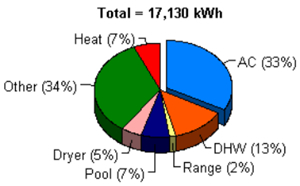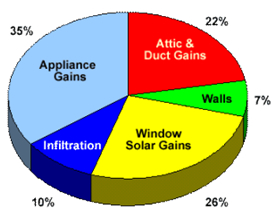


III. BAIHP Research
Overview
BAIHP conducts research with Industry Partners in manufactured and site built housing and using the laboratory facilities at the Florida Solar Energy Center.
Research Context for Hot-Humid Climate
The primary opportunities for improving energy efficiency can be generalized into two categories: increasing equipment efficiency and reducing equipment loads. The latter of these contributes to improving comfort, durability, and indoor air quality also.
In hot humid regions, the primary building energy use (Figure 56) is air conditioning (AC) with heating making up only a small portion of total. As in other climates, water heating constitutes the second largest residential energy draw. Refrigerators follow just ahead of other household appliances such as stoves and dryers.
 |
Figure 56. Distribution of
Residential Energy Consumption measured in 171 Florida homes shows
typical energy profile for homes in Source: Parker, D. S., 2002. "Research
Highlights from |
The primary loads on residential AC systems (Figure 57) are appliance generated heat, window radiant heat gain, attic and duct related heat gain, infiltration (primarily latent heat gain), and wall heat gain coming in last.
 |
Figure 57. Typical components of annual residential cooling load in hot-humid climates.
Source: Florida
Solar Energy Center web site: http://www.fsec.ucf.edu/bldg/fyh/priority/Index.htm |
By systematically evaluating the savings potential technologies and construction techniques, research provides the home building industry with vital information needed to meet the Department of Energy’s industry challenges of building high performance homes. BAIHP Research presented here is grouped into three categories:
-
Manufactured Housing Research
-
Site Built Housing Research
-
Field and Laboratory Building Science Research
BAIHP Home | Overview | Case Studies | Current Data
Partners | Presentations | Publications | Researchers | Contact Us
Copyright © 2002 Florida Solar Energy Center. All Rights Reserved.
Please address questions and comments regarding this web page to BAIHP Master